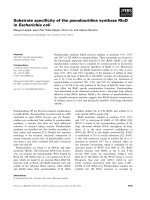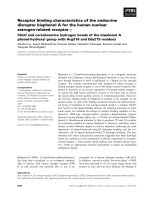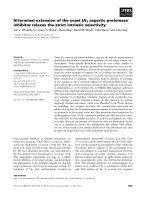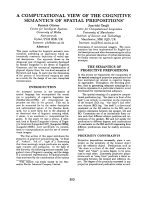báo cáo khoa học: "Cystic cavernous malformation of the cerebellopontine angle: Case report and literature review" pps
Bạn đang xem bản rút gọn của tài liệu. Xem và tải ngay bản đầy đủ của tài liệu tại đây (717.53 KB, 5 trang )
CASE REP O R T Open Access
Cystic cavernous malformation of the
cerebellopontine angle: Case report and
literature review
Haiyan Huang
1†
, Kan Xu
1†
, Limei Qu
2
,YeLi
3
, Jinlu Yu
1*
Abstract
Background: Cavernous malformations (CMs) in the cerebellopontine angle (CPA) are rare, and most of such CMs
reported to date are solid and extend from the internal auditory canal into the CPA. In contrast, cystic CMs that
arise in the CPA and do not involve the internal auditory canal and dura of the skull base are extremely rare.
Case presentation: A 50-year-old man presented with vertigo and progressive hearing loss in the right ear. MRI
examination revealed a lesion in the CPA with solid and cystic components. Surgery was performed. Well-
circumscribed adhesion to cranial nerves, the cerebellum, or the brain stem was noted during surgery. The lesion
was totally resected. Pathological examination suggested the lesion to be a CM. At 1-year follow-up, the symptoms
at presentation had resolved and no complications had occurred.
Conclusion: Although cystic CMs of the CPA have no established imaging features, a diagnosis of CMs may be
suspected when a cystic lesion is present in the CPA and does not involve internal acoustic meatus or dura mater
of the skull base. Skillful microsurgical techniques and monitoring of cranial nerves will secure good outcomes for
patients with cystic CMs in the CPA.
Background
Cavernous malformations (CMs) occur in 0.4-0.8% of
the general population, and they account for 10-15% of
all vascular malformations of the central nervous system
[1,2]. Intracranial CMs are commonly located in the
supratentorial region, brain stem, basal ganglion, and
cerebellar hemisphere [3]. However, CMs arising in the
cerebellopontine angle (CPA) are an extremely rare clin-
ical entity. At present, there are few reports available on
such CMs. The majority of the CMs in the CPA
reported to date are solid lesions that arise from the
internal auditory canal and extend to the CPA [4]. In
contrast,cysticCMsintheCPAareveryuncommon:
Only four cases of cystic CMs in the CPA have been
reported to date, and none involved the internal aud i-
tory canal [5-8]. The exact c auses of cyst formation
remain largely undefined; however, previous studies
have suggested that recurrent minor hemorrhage from
the sinusoids of the vascular malformation or from the
neocapill ary of the cyst wall may underlie the growth of
the cyst [8,9] . Herein, we describe a patient with cystic
CM of the CPA who was admitted to our hospital and
whose lesion was not adherent to the internal auditory
canal or dura of the skull base, together with four simi-
lar cases identified through a literatu re search. Our goal
was to summarize the clinical, radiological, and treat-
ment features of CMs of the CPA.
Case Presentation
A 50-year-old man presented with progressive hearing
loss in the right ear and vertigo for the past 6 months
and facial numbness and unsteady gait for the past 15
days. Upon physical examination, he was found to
have right ear sensory hearing loss, ataxia, diminished
sensationintherightface(suppliedbythethird
branch of the trigeminal nerve), a nd high frequency
hearing loss i n the right ear, as revealed by brain stem
auditory evoked potential examination. MRI examina-
tion revealed a lesion in the CPA with solid and cystic
* Correspondence:
† Contributed equally
1
Department of Neurosurgery, The First Hospital of Jilin University, 71 Xinmin
Avenue, Changchun 130021, PR China
Full list of author information is available at the end of the article
Huang et al. World Journal of Surgical Oncology 2011, 9:36
/>WORLD JOURNAL OF
SURGICAL ONCOLOGY
© 2011 Huang et al; licensee BioMed Central Ltd. This is an Open Access article distributed under the terms of the Creative Common s
Attribu tion License ( which perm its unr estricted use, distribution, and reproduction in
any medium, provided the original work is properly cited.
components, which compressed the brain stem and the
cerebellum. The anterior portion of the lesion was
solid and showed signs of cystic changes, whereas the
posterior portion of the lesion was cystic. The solid
component of the lesion showed hyper- and isointen-
sity on T1WI images and mixed hyper- and hypointen-
sity on T2WI images, and it was significantly enhanced
after contrast administration. The size of the solid
component of the lesion was about 2.2 cm × 2.2 cm ×
2.3 cm (Figure 1). Surgery was performed via a right
suboccipital retrosigmoid approach, and intraoperative
monitoring of cranial nerves was conducted. The
lesion was revealed to be red, well margined, firm, vas-
cular, anteriorly solid with cystic changes, and
adherent to the brain stem and the cerebellar hemi-
sphere, the trigeminal nerve, and facial and acoustic
nerves. Following separation of the lesion from adja-
cent nerves and tissues along the border of the lesion
under microscopy, the lesion was totally resected in a
partitioning manner. The xanthochromic fluid in the
back of the lesion was drained during surgery. The
patient recovered well after surgery and presenting
symptoms were significantly relieved. Postoperative CT
scans demonstrated that the lesion was completely
resected (Figure 2). The histopathological features of
the lesion were consistent with a CM (Figure 3). At 1-
year follow-up, this patient’s symptoms at presentation
had resolved.
A
BC
Figure 1 MRI showed a solid cystic lesion in the right CPA that compressed both the brain stem and t he cerebellum. The anterior
portion of the lesion was solid and showed signs of cystic changes, and the posterior portion of the lesion was cystic. The size of the solid
component was about 2.2 cm × 2.2 cm × 2.3 cm. The solid component showed hyper- and isointensity on T1WI images (A) and mixed intensity
on T2WI images (B), and it was significantly enhanced after contrast administration (C).
Huang et al. World Journal of Surgical Oncology 2011, 9:36
/>Page 2 of 5
Discussion
Locations of CMs are primarily associated with the
volume of the b rain tissues;therefore,CMsaremore
common in supratentorial areas and occasionally are
found in the brain stem, the cerebellum, cranial nerves,
dura mater, and venous sinuses [3,10]. However, the
occurrence of CMs in the CPA is rare, and most of
such CMs reported to date are solid and extend from
the internal auditory canal into the CPA [4]. In contrast,
CMs that arise in the CPA and do not involve the inter-
nal auditory canal and dura of the skull base are extre-
mely rare. To date, only four such cases have been
reported [5-8]. (Table 1). In fact, CMs arising in the
central nervous system are mostly solid, and cystic CMs
are rare. In the present study, we describe an addition al
case of cystic CMs in the CPA (treated in our hospital),
together with the four similar cases previously reported.
A retrospecti ve analysis of the imag ing features of the
five cases revealed that cystic CMs in the CPA had
unspecific imaging manifestations. Of the five cases,
four had large cysts and small nodules and one case had
multiple cysts interspersedinthesolidcomponentof
the lesion. Enhancement of varying degrees was noted
in all five cases. These findings are consistent with the
imaging features of 25 cases of cystic CMs reviewed by
Ohba [9]. Our study also confirms that cystic CMs aris-
ing in the CPA are rare cystic CMs in the central ner-
vous system. Only four such cases (16%) were found
among the 25 cases of cystic CMs reviewed by Ohba
[9]. Herein we reviewed a re latively large series of cystic
CMs in the CPA, including one case encountered in our
institution, in an attempt to outline the clinical and
therapeutic characteristics of cystic CMs in the CPA.
The causes of cystic degeneration of CMs remain
unknown. Recurrent minor hemorrhage of internal vas-
cular sinuses or neocapillaries within CMs may be
involved in the process. When bleeding episodes occur
within a CM, the osmotic pressure across the CM mem-
brane changes, leading to gradual fluid accumulation
within the CM and cystic degeneration, followed by CM
growth [9,11,12]. Cystic degeneration within the CMs in
the CPA is a progressive process, thus CMs may be at
different stages of cystic degeneration when imaging
examinations are performed. Consequently, the CMs
may show various features of cystic degeneration. For
example, multiple cysts may be seen within the solid
component of the CM, and a large cyst may be seen in
combination with small nodules. In addition, cystic CMs
may have different blood supply profiles. All of these fea-
tures co ntribute to different enhancement patterns upon
contrast-enhanced CT or MRI examination, which can
vary from no enhancement at all to marked enhance-
ment. Solid CMs in the brain can show specific MRI
manifestations (e.g., a hypointense rim containing hemo-
siderin deposits on T2WI or DWI sequences) [13,14].
However, out of the five cases described in this report,
only one case showed a rim of hemosiderin deposition.
Cystic degeneration is less severe in small CMs, which
are mostly solid. The characteristic hemosiderin deposi-
tion rim may be caused by the exudated blood from a
hemorrhage, which cannot enter the inside of the CM.
Because of the complex imaging features of cystic CMs
in the CPA, it is difficult to make a correct diagnosis for
such lesions preoperatively, and therefore they are more
likely to be misdiagnosed as other cystic tumors, such as
cystic acoustic neuroma, glioma, and hemangioblastom a
[15-17]. After reviewing the imaging features of the five
cases of cystic CMs in the CPA, we suggest that a
Figure 2 Postopera tive CT examination showed that the CMs
had been completely removed.
Figure 3 Photomicrograph showing the dense clusters of thin-
walled cavernous vascular channels separated by collagenous
septae without any intervening neural tissues. (Original
magnification 200 ×).
Huang et al. World Journal of Surgical Oncology 2011, 9:36
/>Page 3 of 5
diagnosis of cystic CMs may be suspected when a cystic
lesion with no involvement of the internal auditory
canal and skull base dura is present in the CPA.
Due to the small space of the CPA and the complex
surrounding anatomical structures, the presence of CMs
will affect the root of the 5
th
-11
th
cranial nerves, the
cerebellum, and the brain stem a nd result in clinical
symptoms. The five cases in the present study presented
with symptoms involving the trigeminal nerve, facial
and acoustic ne rves, and the cerebellum . However, they
did not show symptoms of brain stem compression,
which may be because the CM likely grows toward the
CPA cistern. The trigeminal nerve, facial and acoustic
nerves, and the c ochlear nerve are quite sensitive, thus
even a small CM may cause pronounced clinical symp-
toms. Therefore, surgical resection is indicated for such
CMs.ThefivepatientswithcysticCMsdescribed
herein underwent surgical resection via a suboccipital
retrosigmoid approach with cranial nerve monitoring.
Particular care was tak en to protect facial and acoustic
nerves and the brain stem from injury so as to avert
serious postoperative complications. We found that the
CMs arising in the CPA adhered to cranial nerves, the
cerebellum, the brain stem, and arteries. However, the
adhesion seemed to be well circumscribed to allow
separation.
The findings described above are in contrast with
solid CMs in the CPA, the majority of which arise in
the internal auditory canal and have close adhesion
with the 7
th
and 8
th
cranial nerves. It is quite difficult
to free solid CMs from the closely adhered nerves,
and more often than not such operations cause clini-
cal symptoms [4]. In addition to taking into account
the surrounding nerves while performing surgical
resection for cystic CMs in the CPA, neurosurgeons
also need to evalua te the degree of blood supply, as
this is another critical factor that determines the suc-
cess of surgical resection. Of the five cases reported
herein, four had a rich blood supply and one had a
poor blood supply. In one case of a cystic CM with a
rich blood supply, total surgical resection had to be
performed in two stages due to copious hemorrhaging
during the first attempt.
CMs are benign lesions a nd show a favorable prog-
nosis after complete resection. However, possible injury
to cranial nerves during surgery is directly associated
with the surgical outcomes due to the complex struc-
tures of the CPA. Two patients experienced an unevent-
ful recovery. In contrast, one patient died and two
patients did not show improvement in their symptoms,
although they did not develop postoperative complica-
tions. The possible causes of the poor outcomes include
unavailability of cranial nerve monitoring and limited
microsurgical skills in two cases and the failure to co m-
pletely resect the CM in a single attempt in one case
with a rich blood supply.
Table 1 Clinical data for the five cases of cystic CMs in the CPA
NO Author/
Year
Age/
Sex
History Symptoms Radiological findings Surgical findings Outcome
1 Iplikçioğlu/
1986 [5]
30/
Male
7 years Hearing loss,
facial palsy, facial
sensory loss,
headache
CT: solid cystic lesion with a large
cyst and small nodules; slight
enhancement of cyst wall;
calcification within the nodules
Bluish-gray lesion with
xanthochromic fluid. The lesion was
adherent to the brain stem and 7
th
and 8
th
cranial nerves. The lesion did
not have a rich blood supply.
Symptoms were
not resolved and
left facial palsy and
hearing loss
persisted.
2 Brunori/
1996 [6]
60/
Male
2
months
Facial sensory
loss, tinnitus,
vertigo, ataxia
MRI: solid cystic lesion with
multiple cysts; marked
enhancement of the solid
component; hemosiderin
deposition rim bordering the
lesion
Reddish-blue, mulberry like lesion
with xanthochromic fluid. The lesion
was adherent to the brain stem and
7
th
and 8
th
cranial nerves. The lesion
had a rich blood supply.
The patient died
due to massive
hemorrhage on
the third
postoperative day.
3 Vajramani/
1998 [7]
46/
Male
7
months
Headache,
tinnitus, vertigo,
hearing loss,
right cerebellar
signs
CT and MRI: solid cystic lesion
with a large cyst and small
nodules; the nodules were
enhanced after contrast
administration
Red lesion with xanthochromic fluid.
The lesion was adherent to the brain
stem and was excised in two stages.
The lesion had a rich blood supply.
Symptoms were
not resolved but
no complications
developed.
4 Stevenson/
2005 [8]
57/
Male
Not
available
Hearing loss,
tinnitus, facial
numbness and
facial sensory
loss, ataxia
MRI: solid cystic lesion a large cyst;
the cystic wall was enhanced
Lobulated lesion with xanthochromic
fluid. The lesion was adherent to the
brain stem and the 5
th
,7
th
-11
th
cranial nerves. The lesion had a rich
blood supply.
Good recovery.
5 Present
case/2010
50/
Male
6
months
Impaired
hearing, vertigo,
ataxia, facial
numbness
MRI: solid cystic lesion with a
posterior cystic component;
marked enhancement of the solid
component on contrast-enhanced
MRI
Red lesion adherent to the
brainstem, cerebellum, and 5
th
,7
th
,
and 8
th
cranial nerves. The lesion
had a rich blood supply.
Good prognosis
Huang et al. World Journal of Surgical Oncology 2011, 9:36
/>Page 4 of 5
Conclusions
In conclus ion, although cystic CMs in the CPA have no
specific imaging features, neurosurgeons should consider
the likelihood of CMs w hen a cystic lesion with no
adhesion to the internal auditory canal a nd skull base
dura mater is present in the CPA. Although cystic CMs
also involve cranial nerves, the cerebellum, the brain
stem, and arteries, they can be separated from these sur-
rounding structures because of the presence of well-
margined adhesions; this trait is not present in solid
CMs. Skillful microsurgical techniques and cranial nerve
monitoring are two critical factors that can ensure a
favorable curative outcome in most cases of cystic CMs
in the CPA.
Consent
Written informed consents were obtained from the
patient for publication of this case report and ac compa-
nying images. Copies of the written consent are available
for review upon request.
Acknowledgements
The authors thank Medjaden Bioscience Limited for assisting in the
preparation of this paper.
Funding support: This study had no funding support.
Author details
1
Department of Neurosurgery, The First Hospital of Jilin University, 71 Xinmin
Avenue, Changchun 130021, PR China.
2
Department of Pathology, The First
Hospital of Jilin University, 71 Xinmin Avenue, Changchun 130021, PR China.
3
Department of Radiology, The First Hospital of Jilin University, 71 Xinmin
Avenue, Changchun 130021, PR China.
Authors’ contributions
KX wrote the initial draft. HH and KX contributed equally to this work. JY is
the surgeon. All authors read and approved the final manuscript.
Competing interests
The authors declare that they have no competing interests.
Received: 13 January 2011 Accepted: 23 March 2011
Published: 23 March 2011
References
1. Bertalanffy H, Benes L, Miyazawa T, Alberti O, Siegel AM, Sure U: Cerebral
cavernomas in the adult. Review of the literature and analysis of 72
surgically treated patients. Neurosurg Rev 2002, 25:1-53.
2. Batra S, Lin D, Recinos PF, Zhang J, Rigamonti D: Medscape: Cavernous
malformations: natural history, diagnosis and treatment. Nat Rev Neurol
2009, 5:659-70.
3. Martin NA, Vinters H: Pathology and grading of intracranial vascular
malformation.Edited by: Barrow DL. Intracranial Vascular Malformation. Park
Ridge, IL: AANS; 1990:1-30.
4. Engh JA, Kostov D, St Martin MB, Yeaney G, Rothfus W, Hirsch B,
Kassam AB: Cavernous malformation tumors: a case study and review of
the literature. Otol Neurotol 2010, 31:294-8.
5. Iplikçioğlu AC, Benli K, Bertan V, Ruacan S: Cystic cavernous hemangioma
of the cerebellopontine angle: case report. Neurosurgery 1986, 19:641-2.
6. Brunori A, Chiappetta F: Cystic extra-axial cavernoma of the
cerebellopontine angle. Surg Neurol 1996, 46:475-6.4.
7. Vajramani GV, Devi BI, Hegde T, Srikanth SG, Shankar SK: Cystic cavernous
malformation of the cerebellopontine angle. Clin Neurol Neurosurg 1998,
100:133-7.
8. Stevenson CB, Johnson MD, Thompson RC: Cystic cavernous malformation
of the cerebellopontine angle. Case illustration. J Neurosurg 2005, 103:931.
9. Ohba S, Shimizu K, Shibao S, Nakagawa T, Murakami H: Cystic cavernous
angiomas. Neurosurg Rev 2010, 33:395-400.
10. Batra S, Lin D, Recinos PF, Zhang J, Rigamonti D: Medscape: Cavernous
malformations: natural history, diagnosis and treatment. Nat Rev Neurol
2009, 5:659-70.
11. Sato K, Kubota T: Large calcified cystic cavernous angioma in the
thalamus–case report. Neurol Med Chir (Tokyo) 1995, 35:100-3.
12. Hatashita S, Miyajima M, Koga N: Cystic cavernous angioma–case report.
Neurol Med Chir (Tokyo) 1991, 31:414-6.
13. Pinker K, Stavrou I, Knosp E, Trattnig S: Are cerebral cavernomas truly
nonenhancing lesions and thereby distinguishable from arteriovenous
malformations? MRI findings and histopathological correlation. Magn Reson
Imaging 2006, 24:631-7.
14. Hauck EF, Barnett SL, White JA, Samson D: Symptomatic brainstem
cavernomas. Neurosurgery 2009,
64:61-70.
15. Yagi K, Kageji T, Nagahiro S, Murayama Y: Multiple cystic cavernous
angiomas associated with hemorrhage. Acta Neurochir (Wien) 2005,
147:201-3.
16. Tomlinson FH, Houser OW, Scheithauer BW, Sundt TM Jr, Okazaki H,
Parisi JE: Angiographically occult vascular malformations: a correlative
study of features on magnetic resonance imaging and histological
examination. Neurosurgery 1994, 34:792-9.
17. Pozzati E, Acciarri N, Tognetti F, Marliani F, Giangaspero F: Growth,
subsequent bleeding, and de novo appearance of cerebral cavernous
angiomas. Neurosurgery 1996, 38:662-9.
doi:10.1186/1477-7819-9-36
Cite this article as: Huang et al.: Cystic cavernous malformation of the
cerebellopontine angle: Case report and literature review. World Journal
of Surgical Oncology 2011 9:36.
Submit your next manuscript to BioMed Central
and take full advantage of:
• Convenient online submission
• Thorough peer review
• No space constraints or color figure charges
• Immediate publication on acceptance
• Inclusion in PubMed, CAS, Scopus and Google Scholar
• Research which is freely available for redistribution
Submit your manuscript at
www.biomedcentral.com/submit
Huang et al. World Journal of Surgical Oncology 2011, 9:36
/>Page 5 of 5









